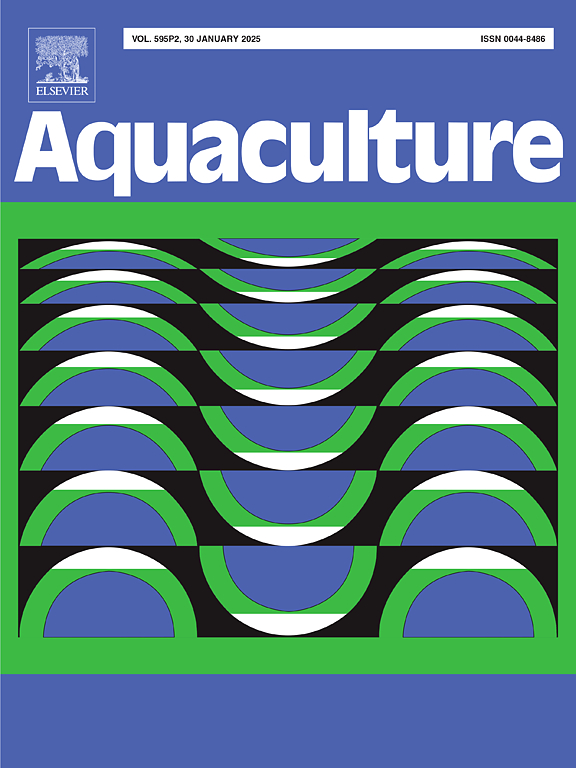Vibrio parahaemolyticus infection induces time-dependent ferroptosis in the liver of silver pomfret (Pampus argenteus)
IF 3.9
1区 农林科学
Q1 FISHERIES
引用次数: 0
Abstract
The silver pomfret (Pampus argenteus), an economically important species in China, which is susceptible to Vibrio infection during farming. Vibrio parahaemolyticus is a gram-negative bacterium that is known to cause significant infections in marine fish. However, the molecular mechanisms underlying the silver pomfret's response to V. parahaemolyticus infection remain unclear. In this study, healthy silver pomfrets were included in the control group. Artificial infection of silver pomfrets was performed via intraperitoneal injection, and the hepatic responses were analyzed at multiple post-infection time points, including 3, 12, 24 and 48 h post-infection (hpi). A total of 50 fish (10 per group) were used, including controls and infected groups at multiple time points. Histopathological changes were observed in infected tissues. Furthermore, Integrated analysis of differentially expressed genes (DEGs) and Weighted Gene Coexpression Network Analysis (WGCNA) identified a temporally regulated defense cascade in silver pomfrets following V. parahaemolyticus infection. This cascade is characterized by sequential phase transitions: early cell death at 3 hpi, an oxidative stress response at 12 hpi, antibody presentation at 24 hpi, and metabolic regulation at 48 hpi. Interestingly, gene set enrichment analysis (GSEA) revealed persistent activation of the ferroptosis signaling pathway. Additionally, WGCNA identified several hub genes, including usp5, fbxw7, maff and ldha, which have been reported to be associated with the occurrence of ferroptosis. Therefore, ferroptosis was selected as the focus of our subsequent research. Measurements of ferroptosis-related markers (genes, Fe2+, oxidative stress, and key proteins) revealed that the ferroptotic response in silver pomfret exhibited a time-dependent and progressively intensified pattern during V. parahaemolyticus infection. These findings provide valuable insights into the acute immune response of silver pomfrets challenged with V. parahaemolyticus and establish a foundation for identifying molecular targets and developing therapeutic interventions against Vibrio infections in economically important marine fish farming.

副溶血性弧菌感染引起银鲳鱼肝脏时间依赖性铁下垂
银鲳鱼(Pampus argenteus)是中国重要的经济物种,在养殖过程中易感染弧菌。副溶血性弧菌是一种革兰氏阴性细菌,已知可在海鱼中引起严重感染。然而,银鲳鱼对副溶血性弧菌感染反应的分子机制尚不清楚。本研究以健康银鲳鱼为对照组。通过腹腔注射人工感染银鲳鱼,并在感染后3、12、24和48 h (hpi)多个时间点分析肝脏反应。在多个时间点共使用50只鱼(每组10只),包括对照组和感染组。感染组织出现组织病理学改变。此外,差异表达基因(DEGs)和加权基因共表达网络分析(WGCNA)的综合分析发现,副溶血性弧菌感染后,银鲳鱼体内存在暂时调节的防御级联反应。这个级联的特点是连续的相变:3 hpi时细胞早期死亡,12 hpi时氧化应激反应,24 hpi时抗体呈递,48 hpi时代谢调节。有趣的是,基因集富集分析(GSEA)揭示了铁下垂信号通路的持续激活。此外,WGCNA还发现了几个枢纽基因,包括usp5、fbxw7、maff和ldha,这些基因被报道与铁下垂的发生有关。因此,我们选择上睑下垂作为我们后续研究的重点。对吸铁相关标记(基因、铁离子、氧化应激和关键蛋白)的测量显示,在副溶血性弧菌感染期间,鲳鱼的吸铁反应表现出时间依赖性和逐渐增强的模式。这些发现为研究副溶血性弧菌对银鲳鱼的急性免疫反应提供了有价值的见解,并为确定具有重要经济意义的海洋养鱼弧菌感染的分子靶点和开发治疗干预措施奠定了基础。
本文章由计算机程序翻译,如有差异,请以英文原文为准。
求助全文
约1分钟内获得全文
求助全文
来源期刊

Aquaculture
农林科学-海洋与淡水生物学
CiteScore
8.60
自引率
17.80%
发文量
1246
审稿时长
56 days
期刊介绍:
Aquaculture is an international journal for the exploration, improvement and management of all freshwater and marine food resources. It publishes novel and innovative research of world-wide interest on farming of aquatic organisms, which includes finfish, mollusks, crustaceans and aquatic plants for human consumption. Research on ornamentals is not a focus of the Journal. Aquaculture only publishes papers with a clear relevance to improving aquaculture practices or a potential application.
 求助内容:
求助内容: 应助结果提醒方式:
应助结果提醒方式:


